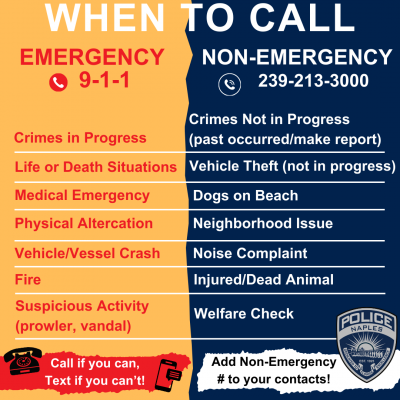When to Call 9-1-1?
When to Dial 9-1-1: Emergency or Non-emergency?
As it pertains to 9-1-1, an “Emergency” is “A life-threatening situation, fire, or crime in progress that may result in serious bodily injury or damage to public or private property.” Below are some examples of valid reasons for dialing 9-1-1, and some situations for which you should call the non-emergency phone number, not 9-1-1.
Clearly, these examples do not cover all situations. To help you determine if your situation is an emergency, ask yourself, “Are police, fire-rescue, or medical assistance needed right now to protect life or property? If you answer, “Yes,” or you are unsure, immediately dial 9-1-1 and fully cooperate with the PST who answers your call.
What You Can Do to Help Us Help You
You can assist the PST and units that will respond to your emergency by following these guidelines:
- Place a voice call to 9-1-1.
- Voice communications have the highest priority over the Public Switch Telephone System (especially for wireless carriers).
- Photos and video require the transmission of large data packets which can take a long time to send and/or receive. These should only be submitted when prompted by the PST who answers your call.
- Text messages have the lowest priority and typically incur a lag in the “Conversation” process (i.e., the back and forth between sender and recipient). Use text-to-911 when voice communication is not a practicable or safe option.
- Remain calm and speak clearly.
- Answer all questions posed by the PST.
- The two most important initial questions are, “What is the nature of your emergency?” and “What is the address of the emergency?” (which may not be the same as your location). Once you provide call nature and location, the PST enters your information in our computer-aided dispatch (CAD) system to initiate dispatch of units to help you.
- While you are relating additional information to he PST, emergency responders are enroute to your locations. The interactions between you and the PST are essential and will not delay unit response.
- Follow the PST’s instructions. Your cooperation could make the difference between life and death.
- PSTs may receive several simultaneous 9-1-1 calls. If a PST puts you on hold, be patient and do not hang up.

